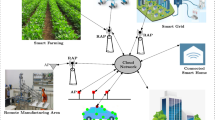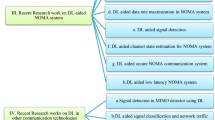Abstract
According to ITU-R, 5G wireless communication’s primary goal is achieving too high data rates in the broadcast region. Polar coding has emerged as a pivotal channel coding technique for 5G to accomplish the previously mentioned goals. Subsequently, the Polar- Coded Non-Orthogonal Multiple Access (PC-NOMA) is observed as a favorable channel accessing technique for sporadic traffic of low data rate devices in a 5G Internet of Things (IoT) environment. Deep Learning algorithms are getting revolutionized in data analysis, Prediction, and decision-making by employing neural network hierarchy. When these Deep Learning algorithms get incorporated in channel estimation or resource allocation of Polar-coded NOMA, they appear to be a promising and robust solution for an uncertain channel. Meanwhile, ultra-reliable low-latency communication, one among the vital 5G use cases, has tremendous potential applications in the Internet of things generation. Consequently, the challenges of integrating deep learning techniques with PC-NOMA for URLLC use cases are reviewed, and the adaptability of Deep Learning algorithms for channel estimation and resource allocation of NOMA are surveyed here.
Access this chapter
Tax calculation will be finalised at checkout
Purchases are for personal use only
Similar content being viewed by others
References
Shannon, C.: A mathematical theory of communication. Bell Syst. Tech. J. 27, 379–423, 623–656. Math. Rev. (MathSciNet) MR10, 133e (1948)
Arikan, E.: Channel polarization: a method for constructing capacity-achieving codes for symmetric binary-input memoryless channels. IEEE Trans. Inf. Theory 55(7), 3051–3073 (2009)
Bioglio, V., Condo, C., Land, I.: Design of polar codes in 5g new radio. arXiv preprint (2018). arXiv:1804.04389
Babar, Z., et al.: Polar codes and their quantum-domain counterparts. In: IEEE Commun. Surv. Tutor. 22(1), 123–155. Firstquarter (2020). https://doi.org/10.1109/COMST.2019.2937923
Dai, J., Niu, K., Si, Z., Dong, C., Lin, J.: Polar-coded non-orthogonal multiple access. IEEE Trans. Signal Process. 66(5), 1374–1389 (2018). https://doi.org/10.1109/TSP.2017.2786273
Gui, G., Huang, H., Song, Y., Sari, H.: Deep learning for an effective nonorthogonal multiple access scheme. IEEE Trans. Veh. Technol. 67(9), 8440–8450 (2018). https://doi.org/10.1109/TVT.2018.2848294
Sutton, G.J., et al.: Enabling technologies for ultra-reliable and low latency communications: from PHY and MAC layer perspectives. IEEE Commun. Surv. Tutor. 21(3), 2488–2524. Thirdquarter (2019). https://doi.org/10.1109/COMST.2019.2897800
Zhang, M., Lou, M., Zhou, H., Zhang, Y., Liu, M., Zhong, Z.: Non-orthogonal coded access based uplink grant-free transmission for URLLC. In: IEEE/CIC International Conference on Communications in China (ICCC), Changchun, China, pp. 624–629 (2019). https://doi.org/10.1109/ICCChina.2019.885590
Alamdar-Yazdi, A., Kschischang, F.R.: A simplified successive-cancellation decoder for polar codes. IEEE Commun. Lett. 15(12), 1378–1380 (2011). https://doi.org/10.1109/LCOMM.2011.101811.111480
Tal, I., Vardy, A.: List decoding of polar codes. IEEE Trans. Inf. Theory 61(5), 2213–2226 (2015)
Afisiadis, O., Balatsoukas-Stimming, A., Burg, A.: A low-complexity improved successive cancellation decoder for polar codes. In: Asilomar Conference on Signals, Systems and Computers, pp. 2116–2120 (2014)
Condo, C., Ercan, F., Gross, W.J.: Improved successive cancellation flip decoding of polar codes based on error distribution. arXiv preprint (2017). arXiv:1711.11096)
Li, B., Shen, H., Tse, D.: An adaptive successive cancellation list decoder for polar codes with cyclic redundancy check. IEEE Commun. Lett. 16(12), 2044–2047 (2012)
Xu, S., Luo, F.-L.: Machine Learning for Future Wireless Communications, 1st edn. Wiley (2020)
Cammerer, S., Gruber, T., Hoydis, J., ten Brink, S.: Scaling deep learning-based decoding of polar codes via partitioning. In: IEEE Global Communications Conference, Singapore (2017). https://doi.org/10.1109/GLOCOM.2017.8254811
Doan, N., Ali Hashemi, S., Gross, W.J.: Neural successive cancellation decoding of polar codes. In: IEEE 19th International Workshop on Signal Processing Advances in Wireless Communications (SPAWC), Kalamata, pp. 1–5 (2018). https://doi.org/10.1109/SPAWC.2018.8445986
Yuan, C., Wu, C., Cheng, D., Yang, Y.: Deep learning in encoding and decoding of polar codes. J. Phys. Conf. Ser. 1060(1), 012021. IOP Publishing (2018)
Liang, F., Shen, C., Wu, F.: An iterative BP-CNN architecture for channel decoding. IEEE J. Sel. Top. Sig. Process. 12(1), 144–159 (2018)
Wen, C., Xiong, J., Gui, L., et al.: A novel decoding scheme for polar code using convolutional neural network. In: 2019 IEEE International Symposium on Broadband Multimedia Systems and Broadcasting (BMSB). IEEE, Jeju, Korea (South), pp. 1–5 (2019)
Gruber, T., Cammerer, S., Hoydis, J., ten Brink, S.: On deep learning-based channel decoding. In: Annual Conference on Information Sciences and Systems (CISS), pp. 1–6 (2017
Nachmani, E., et al.: Learning to decode linear codes using deep learning. In: 54th Annual Allerton Conference on Communication, Control, and Computing (Allerton), Monticello, IL, pp. 341–346 (2016)
Song, X., Zhang, Z., Wang, J., Qin, K.: A graph-neural-network decoder with MLP-based processing cells for polar codes. In: 2019 11th International Conference on Wireless Communications and Signal Processing (WCSP). IEEE, Xi’an, China, pp. 1–6 (2019)
Xu, W., Wu, Z., Ueng, Y.-L., You, X., Zhang, C.: Improved polar decoder based on deep learning. In: IEEE International Workshop on Signal Processing Systems (SiPS), pp. 1–6 (2017)
Lyu, W., Zhang, Z., Jiao, C., Qin, K., Zhang, H.: Performance evaluation of channel decoding with deep neural networks. IEEE International Conference on Communication (ICC), pp. 1–6 (2018)
Liu, X., Wu, S., Wang, Y., et al.: Exploiting error-correction-CRC for polar SCL decoding: a deep learning-based approach. IEEE Trans. Cogn. Commun. Netw. 6, 817–828 (2020). https://doi.org/10.1109/TCCN.2019.2946358
Wang, J., Li, J., Huang, H., Wang, H.: Fine-grained recognition of error correcting codes based on 1-D convolutional neural network. Dig. Sig. Process. 99, 102668 (2020). https://doi.org/10.1016/j.dsp.2020.102668
Gao, J., Niu, K., Dong, C.: Exploiting error-correction-CRC for polar SCL decoding. IEEE Access 8, 27210–27217 (2020)
Lugosch, L., Gross, W.J.: Neural offset min-sum decoding. In: 2017 IEEE International Symposium on Information Theory (ISIT) (2017). https://doi.org/10.1016/j.dsp.2020.102668
Dai, B., Liu, R., Yan, Z.: New min-sum decoders based on deep learning for polar codes. In: IEEE International Workshop on Signal Processing Systems (SiPS), Cape Town, pp. 252–257 (2018). https://doi.org/10.1109/SiPS.2018.8598384
He, B., Wu, S., Deng, Y., Yin, H., Jiao, J., Zhang, Q.: A machine learning based multi-flips successive cancellation decoding scheme of polar codes. In: IEEE 91st Vehicular Technology Conference (VTC2020-Spring) 2020, pp. 1–5 (2020)
Fang, J., Bi, M., Xiao, S., et al.: Neural network decoder of polar codes with tanh-based modified LLR over FSO turbulence channel. Opt. Express 28, 1679 (2020). https://doi.org/10.1364/OE.384572
Fang, J., et al.: Neural successive cancellation polar decoder with Tanh-based modified LLR over FSO turbulence channel. IEEE Photon. J. 12(6), 1–10. Art no. 7906110 (2020). https://doi.org/10.1109/JPHOT.2020.3030618
Xu, W., You, X., Zhang, C., Be’ery, Y.: Polar decoding on sparse graphs with deep learning. In: 52nd Asilomar Conference on Signals, Systems, and Computers, Pacific Grove, CA, USA, pp. 599–603 (2018). https://doi.org/10.1109/ACSSC.2018.8645372
Narengerile, Thompson, J.: Deep learning for signal detection in non-orthogonal multiple access wireless systems. UK/China Emerging Technologies (UCET), Glasgow, United Kingdom, pp. 1–4 (2019). https://doi.org/10.1109/UCET.2019.8881888
Kang, J.-M., Kim, I.-M., Chun, C.-J.: Deep learning-based MIMO-NOMA with imperfect SIC decoding. IEEE Syst. J. 14(3), 3414–3417 (2020). https://doi.org/10.1109/JSYST.2019.2937463
Boloursaz Mashhadi, M., Gündüz, D.: Deep learning for massive MIMO channel state acquisition and feedback. J. Indian Inst. Sci. 100(2), 369–382 (2020). https://doi.org/10.1007/s41745-020-00169-2
Cui, J., Ding, Z., Fan, P.: The application of machine learning in mmWave-NOMA systems. In: 2018 IEEE 87th Vehicular Technology Conference (VTC Spring). IEEE, Porto, pp. 1–6 (2018)
Cui, J., Ding, Z., Fan, P., Al-Dhahir, N.: Unsupervised machine learning-based user clustering in millimeter-wave-NOMA systems. IEEE Trans. Wirel. Commun. 17(11), 7425–7440 (2018). https://doi.org/10.1109/TWC.2018.2867180
Budhiraja, I., Tyagi, S., Tanwar, S., Kumar, N., Rodrigues, J.J.P.C.: Tactile internet for smart communities in 5G: an insight for NOMA-based solutions. IEEE Trans. Ind. Inform. 15(5), 3104–3112 (2019). https://doi.org/10.1109/TII.2019.2892763
Ahmad Khan Beigi, N., Soleymani, M.R.: Ultra-reliable energy-efficient cooperative scheme in asynchronous NOMA with correlated sources. IEEE Internet Things J. 6(5), 7849–7863 (2019). https://doi.org/10.1109/JIOT.2019.2911434
Wang, Z., Lv, T., Lin, Z., Zeng, J., Mathiopoulos, P.T.: Outage performance of URLLC NOMA systems with wireless power transfer. IEEE Wirel. Commun. Lett. 9(3), 380–384 (2020). https://doi.org/10.1109/LWC.2019.2956536
Chen, X., Cheng, J., Zhang, Z., Wu, L., Dang, J., Wang, J.: Data-rate driven transmission strategies for deep learning-based communication systems. IEEE Trans. Commun. 68(4), 2129–2142 (2020). https://doi.org/10.1109/TCOMM.2020.2968314
Shlezinger, N., Farsad, N., Eldar, Y.C., Goldsmith, A.J.: ViterbiNet: a deep learning based Viterbi algorithm for symbol detection. IEEE Trans. Wirel. Commun. 19(5), 3319–3331 (2020). https://doi.org/10.1109/TWC.2020.2972352
Besser, K.-L., Lin, P.-H., Janda, C.R., Jorswieck, E.A.: Wiretap code design by neural network autoencoders. IEEE Trans. Inf. Forensic Secur. 15, 3374–3386 (2020). https://doi.org/10.1109/TIFS.2019.2945619
Doğan, S., Tusha, A., Arslan, H.: NOMA with index modulation for uplink URLLC through grant-free access. IEEE J. Sel. Top. Sig. Process. 13(6), 1249–1257 (2019). https://doi.org/10.1109/JSTSP.2019.2913981
Shafin, R., Liu, L., Chandrasekhar, V., Chen, H., Reed, J., Zhang, J.C.: Artificial intelligence-enabled cellular networks: a critical path to beyond-5G and 6G. IEEE Wirel. Commun. 27(2), 212–217 (2020). https://doi.org/10.1109/MWC.001.1900323
Author information
Authors and Affiliations
Editor information
Editors and Affiliations
Rights and permissions
Copyright information
© 2022 The Author(s), under exclusive license to Springer Nature Singapore Pte Ltd.
About this paper
Cite this paper
Iswarya, N., Venkateswari, R., Madhusudanan, N. (2022). A Study on the Adaptability of Deep Learning-Based Polar-Coded NOMA in Ultra-Reliable Low-Latency Communications. In: Iyer, B., Ghosh, D., Balas, V.E. (eds) Applied Information Processing Systems . Advances in Intelligent Systems and Computing, vol 1354. Springer, Singapore. https://doi.org/10.1007/978-981-16-2008-9_4
Download citation
DOI: https://doi.org/10.1007/978-981-16-2008-9_4
Published:
Publisher Name: Springer, Singapore
Print ISBN: 978-981-16-2007-2
Online ISBN: 978-981-16-2008-9
eBook Packages: Intelligent Technologies and RoboticsIntelligent Technologies and Robotics (R0)




